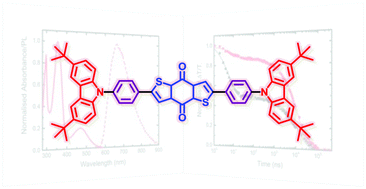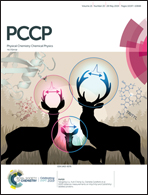Red-shifted delayed fluorescence at the expense of photoluminescence quantum efficiency – an intramolecular charge-transfer molecule based on a benzodithiophene-4,8-dione acceptor†
Abstract
Employing the thiophene based quinone, benzo[1,2-b:4,5-b′]dithiophene-4,8-dione, as the electron-accepting moiety alongside N-phenylcarbazole donors to produce a donor–π–acceptor–π–donor (D–π–A–π–D) molecule has yielded a new red emitter displaying delayed fluorescence. This new molecule shows strongly (over 100 nm) red-shifted emission when compared to an anthraquinone based analogue. Cyclic voltammetry complemented by computational insights prove that this red-shift is due to the significantly stronger electron-accepting ability of the thiophene quinone compared to anthraquinone. Photophysical and computational studies of this molecule have revealed that while the presence of the thiophene containing acceptor facilitates rapid intersystem crossing which is comparable to anthraquinone analogues, the reverse intersystem crossing rate is slow and non-radiative decay is rapid which we can attribute to low-lying locally excited states. This limits the total photoluminescence quantum efficiency to less than 10% in both solution and the solid state. These results provide a useful example of how very minor structural variations can have a defining impact on the photophysical properties of new molecular materials.

- This article is part of the themed collection: Celebrating our 2025 Prizewinners


 Please wait while we load your content...
Please wait while we load your content...